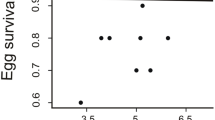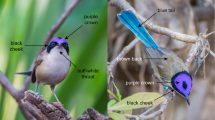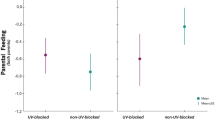Abstract
Brilliant blue and violet structural colours are common plumage ornaments in birds, but their signalling functions are poorly understood1. This may be because birds also communicate in ultraviolet (UV-A) wavelengths (320–400 nm)2,3,4,5, invisible to humans, but a strong spectral component of many structural colours6. From a wild population of blue tits—Parus caeruleus, sexually dimorphic primarily in the ultraviolet7,8—we report experimental evidence that females skew the sex ratio of their offspring in response to the ultraviolet plumage ornamentation of their mates. Masking male ultraviolet reflectance reversed a positive correlation between reflectance and brood sex ratio observed in control pairs, demonstrating a causal effect of male ultraviolet ornamentation on offspring sex ratio. Ultraviolet reflectance also predicted male survival to the following breeding season, suggesting that it serves as a viability indicator. When taken together with ecological effects (laying date, nesting area), our experiments reveal that an unexpected amount of control exists over the primary sex ratio in birds, suggesting that chromosomal sex determination may not constrain the sex ratios of multiparous vertebrates.
This is a preview of subscription content, access via your institution
Access options
Subscribe to this journal
Receive 51 print issues and online access
$199.00 per year
only $3.90 per issue
Buy this article
- Purchase on Springer Link
- Instant access to full article PDF
Prices may be subject to local taxes which are calculated during checkout



Similar content being viewed by others
References
Owens,I. P. F. & Hartley,I. R. Sexual dimorphism in birds: why are there so many different forms of dimorphism? Proc. R. Soc. Lond. B 265, 397–407 (1998).
Bennett,A. T. D., Cuthill,I. C., Partridge,J. C. & Maier,E. J. Ultraviolet vision and mate choice in zebra finches. Nature 380, 433–435 (1996).
Bennett,A. T. D., Cuthill,I. C., Partridge,J. C. & Lunau,K. Ultraviolet plumage colors predict mate preferences in startlings. Proc. Natl Acad. Sci. USA 94, 8618–8621 (1997).
Andersson,S. & Amundsen,T. Ultraviolet colour vision and ornamentation in bluethroats. Proc. R. Soc. Lond. B 264, 1587–1591 (1997).
Johnsen,A., Andersson,T., Örnborg,J. & Lifjeld,J. T. Ultraviolet plumage ornamentation affects social mate choice and sperm competition in bluethroats (Aves: Luscinia s. svecica): a field experiment. Proc. R. Soc. Lond. B 265, 1313–1318 (1998).
Finger,E. & Burkhardt,D. Biological aspects of bird coloration and avian colour vision including the ultraviolet range. Vision Res. 34, 1509–1514 (1994).
Andersson,S., Örnborg,J. & Andersson,M. Ultraviolet sexual dimorphism and assortative mating in blue tits. Proc. R. Soc. Lond. B 265, 445–450 (1998).
Hunt,S., Bennett,A. T. D., Cuthill,I. C. & Griffiths,R. Blue tits are ultraviolet tits. Proc. R. Soc. Lond. B 265, 451–455 (1998).
Charnov,E. L. The Theory of Sex Allocation (Princeton Univ. Press, Princeton, 1982).
Frank,S. A. Sex allocation theory for birds and mammals. Annu. Rev. Ecol. Syst. 21, 13–55 (1990).
Burley,N. Sex-ratio manipulation in color-banded population of zebra finches. Evolution 40, 1191–1206 (1986).
Ellegren,H., Gustafsson,L. & Sheldon,B. C. Sex allocation in response to paternal attractiveness in a wild bird population. Proc. Natl Acad. Sci. USA 93, 11723–11728 (1996).
Svensson,E. & Nilsson,J.-Å. Mate quality affects offspring sex ratio in blue tits. Proc. R. Soc. Lond. B 263, 357–361 (1996).
Kempenaers,B., Verheyen,G. R. & Dhondt,A. A. Extrapair paternity in the blue tit (Parus caeruleus): female choice, male characteristics, and offspring quality. Behav. Ecol. 8, 481–492 (1997).
Kempenaers,B. Polygyny in the blue tit: intra- and inter-sexual conflicts. Anim. Behav. 49, 1047–1064 (1995).
Endler,J. A. On the measurement and classification of colour in studies of animal colour patterns. Biol. J. Linn. Soc. 41, 315–352 (1990).
Møller,A. P. & Ninni,P. Sperm competition and sexual selection: a meta-analysis of paternity studies of birds. Behav. Ecol. Sociobiol. 43, 345–358 (1998).
Krokene,C., Rigstad,K., Dale,M. & Lifjeld,J. T. The function of extrapair paternity in blue tits and great tits: good genes or fertility insurance? Behav. Ecol. 9, 649–656 (1998).
Andersson,M. Sexual Selection (Princeton Univ. Press, Princeton, 1994).
Burley,N. & Coopersmith,C. B. Bill color preferences of zebra finches. Ethology 76, 133–151 (1987).
Hill,G. E. Plumage coloration is a sexually selected indicator of male quality. Nature 350, 337–339 (1991).
Cuthill,I. C., Bennett,A. T. D., Partridge,J. C. & Maier,E. J. Plumage reflectance and the objective assessment of avian sexual dichromatism. Am. Nat. 160, 183–200 (1999).
Andersson,S. Morphology of UV reflectance in a whistling-thrush: implications for the study of structural colour signalling in birds. J. Avian Biol. 30, 193–204 (1999).
Keyser,A. J. & Hill,G. E. Condition-dependent variation in the blue-ultraviolet coloration of a structurally based plumage ornament. Proc. R. Soc. Lond. B 266, 771–777 (1999).
Krackow,S. Potential mechanisms for sex ratio adjustment in mammals and birds. Biol. Rev. 70, 225–241 (1995).
Komdeur,J., Daan,S., Tinbergen,J. & Mateman,A. C. Extreme adaptive modification of the sex ratio of the Seychelles warbler's eggs. Nature 385, 522–525 (1997).
Kilner,R. Primary and secondary sex ratio manipulation by zebra finches. Anim. Behav. 56, 155–164 (1998).
Nager,R. G., Monaghan,P., Griffiths,R., Houston,D. C. & Dawson,R. Experimental demonstration that offspring sex ratio varies with maternal condition. Proc. Natl Acad. Sci. USA 96, 570–573 (1999).
Emlen,S. T. When mothers prefer daughters over sons. Trends Ecol. Evol. 12, 291–292 (1997).
Griffiths,R., Double,M. C., Orr,K. & Dawson,R. J. G. A DNA test to sex most birds. Mol. Ecol. 7, 1071–1075 (1998).
Acknowledgements
We thank A. Dubiec, K. Oddie, U. Unger and M. Liungman for assistance, and M. Andersson, A. Bennett, N. Burley, I. Cuthill, K. Lessells, J. Merilä, S. Verhulst and M. Zuk for comments. This work was supported by the Swedish Natural Sciences Research Council (B.C.S. and S.A.), and a scholarship from the Swedish Institute (J.S.).
Author information
Authors and Affiliations
Corresponding author
Rights and permissions
About this article
Cite this article
Sheldon, B., Andersson, S., Griffith, S. et al. Ultraviolet colour variation influences blue tit sex ratios. Nature 402, 874–877 (1999). https://doi.org/10.1038/47239
Received:
Accepted:
Issue Date:
DOI: https://doi.org/10.1038/47239
Comments
By submitting a comment you agree to abide by our Terms and Community Guidelines. If you find something abusive or that does not comply with our terms or guidelines please flag it as inappropriate.



